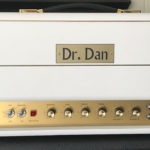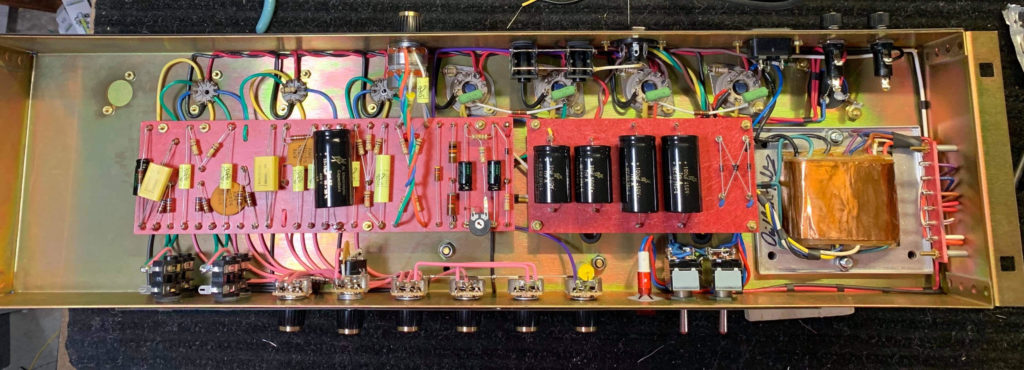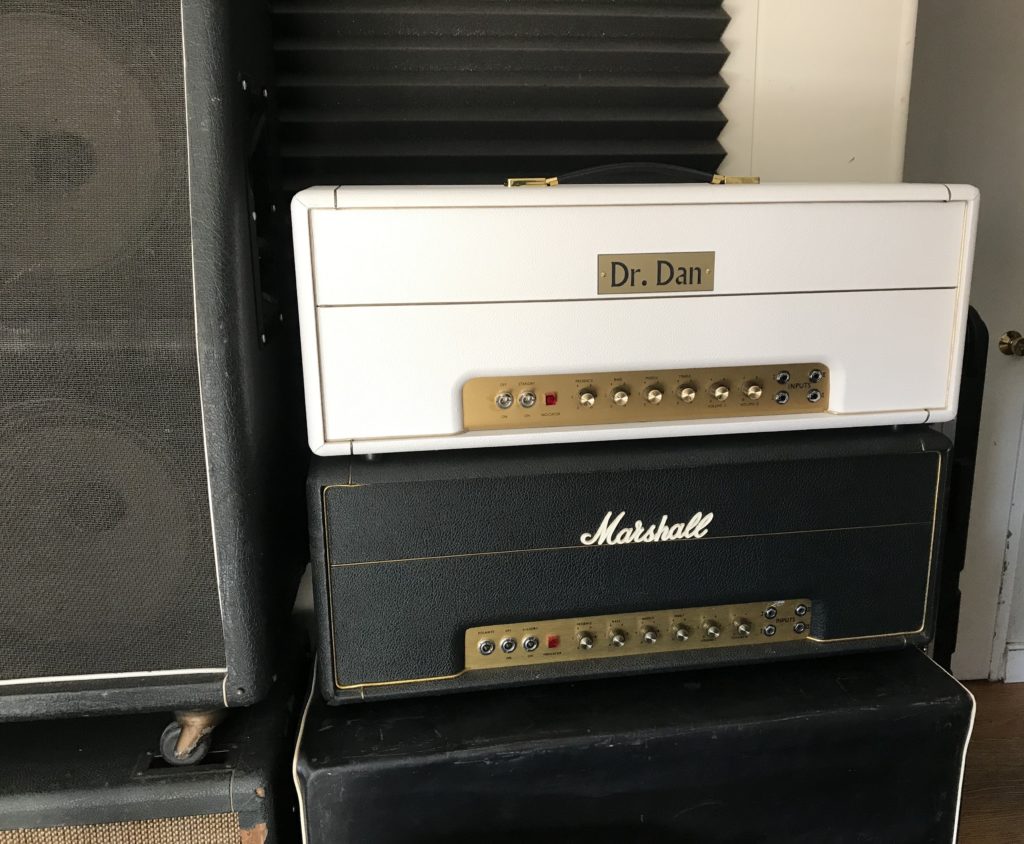 Many amplifiers have come and gone in my music room through the years, and a small handful have been genuinely missed. One in particular that I was always interested in having back in the fold was an original 1968 Marshall model 1959 Super Lead with the serial number range in the 12,000s. I owned just one many years ago but had needed to sell it, along with many other pieces, during a more challenging time in life. The memory of that amp remained with me through the years that followed as it had that perfect blend of creaminess and crunch in its tone as well as a feel that delivered the perfect amount of compression. Indeed, it was truly one of the good ones. And no doubt the best Marshall I’ve ever had.
Many amplifiers have come and gone in my music room through the years, and a small handful have been genuinely missed. One in particular that I was always interested in having back in the fold was an original 1968 Marshall model 1959 Super Lead with the serial number range in the 12,000s. I owned just one many years ago but had needed to sell it, along with many other pieces, during a more challenging time in life. The memory of that amp remained with me through the years that followed as it had that perfect blend of creaminess and crunch in its tone as well as a feel that delivered the perfect amount of compression. Indeed, it was truly one of the good ones. And no doubt the best Marshall I’ve ever had.
This particular series was not just desirable to me though, as it had become famous and most well known as the amp series that Edward Van Halen used to record the early classic Van Halen albums. Certainly there were other factors at play that generated his tone: his use of a Variac to reduce the AC voltage and sag the signal, his pickups, his Marshall straight-front basketweave B cabinet and speaker choices, the various signal processing tools, and of course and most importantly, his tremendous technique and overall approach to the guitar. But all that considered, his number one Marshall Super Lead with the 12,000 series serial number was still a major contributor in delivering the tone that forever changed how we viewed what rock guitar should sound like.
Fast forward to last year in 2020 when I began my search for another 12,000 series Super Lead to purchase and bring home to the rehearsal room. Not many 1965-1969 Marshall plexi amps are generally available for sale, much less the particular one I was seeking. In fact, only approximately 400 were produced in the 12,000 series, so they are scarce.
After reaching out to several connections in the industry and friends, in time I was able to locate, not just one, but two of these amplifiers to examine. That was a good start, but unfortunately, the first one I checked out which was located in England had not been in storage and not operated in two decades, and also had a heavily rusted chassis with rusty transformers. Most of the components on the board were original, but the amp still needed serious work, and the outside headbox was certainly not in very good condition either. We couldn’t agree on a price as the seller was looking to get a high 4-figure number (in USD). Without knowing the true condition of the key transformers in the amp as it wasn’t operational, it wasn’t worth the risk to me.
The next amp I located was stellar. A nearly mint, fantastic example of a 12,000 series Super Lead, which was also in Europe. I made an offer (the amp wasn’t actively for sale) but my offer of a very high 4-figure amount USD was not enough to secure the amp, as the owner wanted an amount into the 5-figures. This was beyond my budget so I moved on. I won’t comment on the market and values of these amps other than to say something is ultimately worth what someone else is willing to pay. And with limited numbers of these amps out there, I’m sure there’s someone out there for these amps.
Around this same time I became aware of Dan Tramble, of Dr. Dan custom amplifiers out of Nova Scotia, Canada. After sharing my story and then learning about how Dan himself was passionate over the details and that he closely studied the particular characteristics of the famed EVH Marshall, I commissioned a custom amp from him.
So my 1968 Replica JMP 1959 12,000 series amplifier was to be built to the following specifications:
Merren Audio Dagnall T2562 PT (1.8″ stack height featuring flux band) and, running 465 B+
Merren Audio Dagnall C1998 OT (1.5″ stack height”)
Merren Audio C1999 choke
Cliff UK tube sockets and input jacks, genuine Marshall output impedance selector, IEC connector, CTS pots or Alpha, reproduction knob set, pilot lamp and switch rings. Plexi front and rear faceplates. Custom made 5/8 reproduction 100 watt large plexi headbox with no upcharge for various tolex colors. Chassis is a reproduction 12,000 series and steel (gold anodized) type.
SoZo or Synergy Mustard caps, CDE mica caps and 1w carbon film resistors; filters are F&T throughout and cathode/bias caps are Sprague Atom series. Tube compliment is either JJ EL34/12AX& MG or Tubestore Preferred series (dependent on supply).
Built on a fully perfed turret board, soldered at each connection with 360 degree mechanical connections on turrets. All amps in North America are wired 120 VAC mains and a terminal strip on the end of the chassis terminates the various voltages the Merren T2562 is capable of.
Master volume (PPIMV) is optional and a upcharge. (Note: Even though this wouldn’t be accurate to the original VH amp, I still chose this option as I wanted the flexibility to use a master volume. And with a post-phase inverter design, when the master volume is turned all the way up, its effectively out of the circuit).
According to Dan himself, here’s what he shared additionally about the amp.
“This is my take on the early VH style amplifier, filtering is low and enhanced the ‘percussiveness’ of this particular amplifier. Has the split cathode arrangement on V1 and a bypass cap on V2a. On volume II this amp is very midrange dominant and bright, with the Merren Audio reproduction transformers, the amp has a very dynamic feel and attack which was limited to the earlier 12,000 series super lead amplifiers made in 1968.
“This amp can be built one of two ways 1) with Merren Audio as standard transformer supply with approx 465 B+ or 2) Custom Mercury Magnetic Transformers. I took a T2562 and ran it at 89 VAC and recorded the B+ and had mercuty maske me this exact PT with HT voltages lower as in running at 89 VAC with a variac!”

I took the Merren transformer option which puts the amp at $3000 USD with the Mercury option starting at $3250 USD. Just a side note on Chris Merren as I’ve had conversations with him over the years. I’ve found him to be incredibly helpful educating me about every minute detail of transformers and his knowledge of how they were built in the past. From the grades of iron ore used to the electronics around them, he knows all about the true secret sauce as well as the happy accidents that were put into some of these which produced those great tones. All said, while I’ve known Chris for a long time, this would be my first experience actually playing an amp using one of his transformer sets so I was excited and curious.

The amp was completed (I chose to receive it in a white headshell), and when it arrived and I plugged in my Les Paul Custom, I must say I was floored and just absolutely blown away. Playing through my 1970 B Marshall cabinet loaded with pre-Rola G12M-25 watt speakers with original Pulsonic cones, the amp delivered everything I expected a great Marshall of this era to do. With my Les Paul in hand, this tone breathed and sang with a harmonically-rich push of classic mids, with dynamics easily controllable as the amp was very touch-responsive. The midrange was punchy, and the amp was was never overly bright or piercing as some Marshalls could be.
The gain this amp produces is a little less than my other model 1959 Super Lead does from 1972, but what this lacked in gain, it made up for feel and a warm rich body overall. 1972 was in fact known as a particularly aggressive year for Marshalls and it’s a fantastic amp in its own right. But for those who want the EVH “Brown Sound,” the 1972 year is actually just a bit much for both gain and top end. The Dr. Dan spec’d 12,000 series is really where to find that particular Van Halen sound as it has the clarity required to clearly ring out those harmonics and produce that perfect balance of compression.

For those searching for a handbuilt amp made to the exact spec of the EVH type Marshall #1 amp, or another era, you won’t go wrong with a build by Dr. Dan amps. For right around the price of today’s reissue Marshall 1959HW 100-watt head, an amp that arguably could benefit from some upgrades to get the most out of it, you will have an amp that is superior in ALL aspects of its build. From the components selected, the attention to detail with the meticulous build, to the final result which is a tone you need to hear and feel to experience and appreciate, the Dr. Dan 12,000 series replica delivers. Classic Marshall tone lovers should rejoice if having an expensive original isn’t in your budget, as it should no longer be a concern. Dr. Dan will take care of you. Visit www.drdanamps.com or contact Dan directly at [email protected] to inquire further.